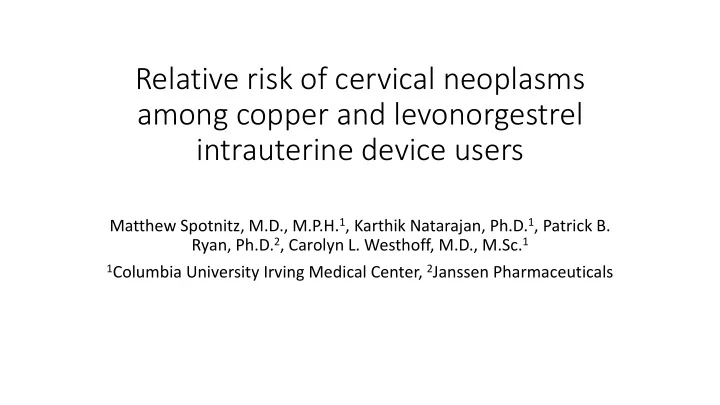

Relative risk of cervical neoplasms among copper and levonorgestrel intrauterine device users Matthew Spotnitz, M.D., M.P.H. 1 , Karthik Natarajan, Ph.D. 1 , Patrick B. Ryan, Ph.D. 2 , Carolyn L. Westhoff, M.D., M.Sc. 1 1 Columbia University Irving Medical Center, 2 Janssen Pharmaceuticals
Intrauterine Devices (IUDs) Variable Cu-IUD LNG-IUS (“Copper”) (“Hormonal”) Available in US 1988 (Paragard) 2000 (Mirena) Number of Users ~80 Million ~20 Million Prevents Pregnancy >99% >99% Inhibits Sperm Yes Yes Thins Uterine Lining No Yes Thickens Mucous No Yes Decreases Bleeding No Yes Decreases Pain No Yes Approximate Cost $700 $800 https://www.theverge.com/2015/4/7/8364721/best-teen-birth-control-iud-implant-cdc https://clearhealthcosts.com/blog/2014/01/much-iud-birth-control-cost-draft/ Nelson A et. al. Open Access J Contracept. 2016; 7: 127–141.
Cervical Cancer Pathophysiology Cohen PA et. al. Lancet 2019 Jan 12;393(10167):169-182.
IUDs and Cervical Cancer: Systematic Review Cortessis VK, Barret M, Wade NQ et. al. Obstetrics & Gynecology (2017) 130(6): 1226-1236.
Methods: Cohorts • Retrospective observational cohort study • Cohorts and estimation analysis were designed in ATLAS • Cu-IUD Cohort (T): CPT Code for first IUD placement, no subsequent LNG- IUS exposure • LNG-IUS Cohort (C): CPT Code for first IUD placement, at least 1 subsequent LNG-IUS exposure • Cervical Neoplasm Cohort (O): Condition code of a high grade cervical neoplasm (i.e. SNOMED ”Primary Malignant Neoplasm of Uterine Cervix”) • All study patients had 365 days prior observation, no history of endometrial or cervical cancer, and were 45 years or younger
Methods: Analysis • Study Window: 1/1/2003 – 12/15/2018 • Study Period: 30 days to 15 years post placement • Subgroup Analysis: 1 to 15 years post placement • Propensity score stratification, propensity score matching, and propensity score matching for the subgroup were performed • Adjusted over more than 10,000 covariates in each analysis and balance was achieved
Cervical Neoplasm Phenotype Validation • Under CUIMC IRB approval (IRB #AAAO7805), we identified 115 cervical neoplasm patients with our phenotype • 90% of cervical neoplasm cases had concordant biopsy diagnosis • 100% of LNG-IUS exposures were identified properly • 10% of Cu-IUD exposures were actually LNG-IUS exposures
Propensity Score Distribution
Matched Cervical Cancer Risk Factors Variable (n, %) Copper Hormonal Before PS Cu-IUD after LNG-IUS after After PS Before Before Matching PS Matching PS Matching Matching Matching Matching Std. Diff (n=2039) (n=2039) Std. Diff (n=8274) (n=2400) Tobacco Smoking 3261 (39.4%) 1290 (53.8%) 0.49* 1077 (52.8%) 1060 (52.0%) 0.02 Behavior HPV Vaccine 43 (0.5%) 27 (1.1%) -0.07 18 (0.9%) 23 (1.1%) -0.02 HPV Test Positive 210 (2.5%) 59 (2.5%) 0.03 38 (1.9%) 55 (2.7%) -0.06
Kaplan-Meier Plot: PS Matching
Possible Explanations for Effect • Differences in risk factors or screening uptake • Harmful effect of synthetic hormones • Protective effect from copper
Screening Uptake Characterization Variable (n, %) Copper Hormonal (n=8274) (n=2400) Median Follow-Up Years 2.8 [0.5-6.5] 2.6 [0.6-5.0] Subsequent Cervical Cancer Screening 2560 (30.9%) 835 (34.8%) 1893 (22.9%) 695 (29.0%) Subsequent Preventive Health Visits
Premarket Randomized Control Trial (RCT): Mirena FDA Application, 2000 • “In the study report based on annual PAP smear data from 2758 women, investigators reported no difference in the rate of dysplasia or cancer between women using Mirena (1821) and those using a copper IUD (937). There were 46 subjects who developed abnormal cervical cytology (Class III, IV, V), 13 in the copper IUD group and 33 in the Mirena group. There was one invasive cervical cancer in the Mirena group (described in section 3.10.1). These differences were not statistically significant.” • No reporting of cervical neoplasms in peer reviewed publications https://www.accessdata.fda.gov/drugsatfda_docs/nda/2000/21-225.pdf_Mirena_Medr.pdf
Proportional Copper vs. Hormonal Results Cohort RCT CUIMC CUIMC CUIMC PS Strat PS Match Crude Cu-IUD 1.4% 1.1% 0.7% 0.9% LNG-IUS 1.8% 1.7% 1.8% 1.5%
Analysis Summary Analysis RR [95% CI] Propensity Score Stratification 0.49 [0.32-0.76] Propensity Score Matching 0.38 [0.16-0.78] Propensity Score Matching Subgroup 0.64 [0.27-1.47] Premarket RCT (n=2758) 0.76 [0.40-1.40] https://www.accessdata.fda.gov/drugsatfda_docs/nda/2000/21-225.pdf_Mirena_Medr.pdf
Hormonal Device Toxicity • “The local endometrial concentrations of levonorgestrel, however, are over 100 times higher in Mirena users than in users of oral contraceptive containing 0.25 mg levonorgestrel.” • Continuous intrauterine exposure for years https://www.accessdata.fda.gov/drugsatfda_docs/nda/2000/21-225.pdf_Mirena_Medr.pdf
Endometrial Effects of Progesterone Exposure Increased Angiogenesis • Increased MMP Activity • Guttinger A, Critchley HOD. Contraception (2007) 75 S93-S98.
Absolute vs. relative effects • Although a direct comparison between IUD users and non-IUD users would be informative, it is difficult to do so in practice • Confounding by intermittent vs. continuous contraception use, and number of pregnancies during the study interval • Therefore, we focus on relative effects of Cu-IUD vs. LNG-IUS
Conclusion • The relative risk of cervical neoplasms for Cu-IUD users was less than that of LNG-IUS users • Our findings were internally consistent and consistent with a premarket RCT • High external validity with healthcare implications for approximately 1 million women • OHDSI is uniquely situated to study the relative risk for other device related adverse events K. Heinemann et. al. Contraception 91(4) (2015) 274-279.
Future Studies • IUD Cervical Neoplasms Network Study • IUD Cervical Neoplasms Prediction Studies • IUD Ovarian Cancer Network Study
Thanks! • Dr. Carolyn Westhoff • Dr. Karthik Natarajan • Dr. Patrick Ryan • CUIMC DBMI • Maura Beaton • OHDSI Community
Recommend
More recommend